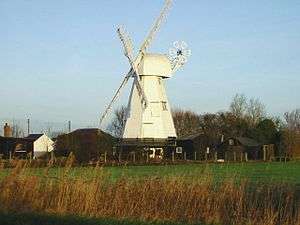White Mill, Sandwich
| White Mill, Sandwich | |
|---|---|
 | |
| Origin | |
| Mill name | White Mill |
| Mill location | Ash Road, Sandwich, Kent |
| Operator(s) | The White Mill Museum Trust Ltd |
| Year built | 1760 |
| Information | |
| Purpose | Corn mill |
| Type | Smock mill |
| Storeys | Three-storey smock |
| Base storeys | Single-storey base |
| Smock sides | Eight-sided |
| Number of sails | Four |
| Type of sails | Spring Sails |
| Windshaft | Cast iron |
| Winding | Fantail |
| Fantail blades | Six bladed |
| Auxiliary power | Engine |
| Number of pairs of millstones | Two pairs driven by wind, third pair driven by engine |
White Mill is a smock mill west of Sandwich, Kent, England that was built in 1760. The mill has been restored and is open to the public as part of the White Mill Rural Heritage Centre. The museum also includes the miller's cottage, which has been furnished to appear as it did between 1900 and 1939. Other displays in the outbuildings include farming and craft tools, wheelwright and blacksmith workshops.
History
White Mill was built in 1760. It was marked on Andrews, Drury and Herbert's map of 1769 and the 1819–43 Ordnance Survey map. The mill was worked by the Stanley family for many years.[1] The mill was last powered by wind in 1926.[2] From then until 1957[3] it was being powered by a 28-horsepower (21 kW) oil engine.
The mill was repaired in the 1960s by Vincent Pargeter before he became a professional millwright. A pair of sails from the demolished Tower mill at Wingham was erected on the mill. The work was initially financed by Pargeter himself but in 1964, the Society for the Protection of Ancient Buildings gave a grant for the purchase of materials to repair the mill. The mill was acquired by Sandwich Borough Council in 1968, and later passed into the ownership of Kent County Council.[2]
Description
White Mill is a three-storey smock mill on a single-storey brick base. It has four spring sails. The mill is winded by a fantail.[1] The mill drives two pairs of millstones by wind, and a third pair is driven by an engine. Much of the machinery is made of wood, including the brake wheel, wallower,[2] great spur wheel, and stone nuts. The millstones are overdrift.[4]
Gallery
- The mill in 2008
 Map of Sandwich, 1945, showing the mill.
Map of Sandwich, 1945, showing the mill.- Brake wheel and wallower.
- The brake wheel.
- The wallower.
- The stone floor.
- Engine driven stones on the meal floor.
- Great Spur Wheel and engine drive.
- Drive to the engine driven stones.
- Drive from the engine to the mill.
Millers
- Thomas Stanley 1878
- Stanley Brothers
- Albert Stanley - 1952
See also
 Windmills in Kent – Wikipedia book
Windmills in Kent – Wikipedia book
References
- 1 2 3 Finch, William Coles (1933). Watermills and Windmills. London: C W Daniel Company. pp. 271–72.
- 1 2 3 4 West, Jenny (1973). The Windmills of Kent. London: Charles Skilton Ltd. pp. 68–71. ISBN 0-284-98534-1.
- ↑ "Welcome to White Mill Rural Heritage Centre". White Mill Rural Heritage Centre. Retrieved 2008-04-19.
- ↑ "White Mill: The Windmill & Machinery". The Mills White Mill Rural Heritage Centre. Retrieved 2008-04-19.
External links
- White Mill Rural Heritage Centre - official site
- Windmill World page on the mill.
Coordinates: 51°16′46″N 1°19′41″E / 51.27944°N 1.32806°E